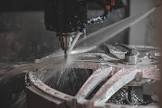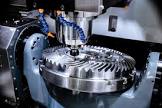🔧 Understanding CNC Turning Inserts: Why They Matter
CNC turning inserts are replaceable cutting tips mounted on tool holders, designed to shape materials with high precision. Their geometry, material, and coating dictate performance in operations like facing, grooving, threading, and profiling.
Key Benefits:
– Extended tool life due to replaceable edges.
– Higher machining speeds with optimized chip control.
– Cost efficiency by reducing downtime and waste.
But selecting the right insert isn’t straightforward—material compatibility, wear resistance, and cutting conditions all play a role. Let’s break down the critical considerations.
📌 Types of CNC Turning Inserts: A Detailed Breakdown
✅ 1. By Material Composition
Different materials handle heat, friction, and wear uniquely.
| Insert Type | Best For | Limitations |
|---|---|---|
| Carbide | High-speed steel, alloys | Brittle under heavy impact |
| Cermet | Finishing stainless steel | Not ideal for roughing |
| Ceramic | High-temp superalloys | Prone to chipping |
| Diamond (PCD/CBN) | Non-ferrous metals, composites | Expensive, specialized use |
Pro Tip: Carbide inserts dominate the market (70%+ usage) due to their balance of durability and cost.
✅ 2. By Geometry & Cutting Edge
- Negative Rake Inserts: Stronger, but require higher cutting force.
- Positive Rake Inserts: Smoother cuts, ideal for softer materials.
- Neutral Rake Inserts: Balanced for general-purpose turning.
✅ 3. By Coating Technology
- TiN (Titanium Nitride): General-purpose, cost-effective.
- TiAlN (Titanium Aluminum Nitride): High-heat resistance (ideal for aerospace alloys).
- Diamond Coating: For abrasive materials like graphite or carbon fiber.
🔥 Top Challenges in CNC Turning Inserts Selection
❌ 1. Premature Wear & Tool Failure
- Flank wear, cratering, and edge chipping shorten insert life.
- Solution: Match coating to material (e.g., TiAlN for high-heat alloys).

❌ 2. Poor Chip Control
- Long, tangled chips damage surfaces and tools.
- Solution: Use inserts with chip breakers (e.g., 3D geometries for stainless steel).

❌ 3. Vibration & Surface Finish Issues
- Chatter leads to poor tolerances.
- Fix: Opt for clamped inserts over screwed ones for stability.
🛠 Best Practices for Optimizing CNC Turning Inserts
- Match Insert Grade to Material
- Steel: Carbide with TiCN coating.
- Aluminum: Uncoated or PCD for mirror finishes.
- Monitor Cutting Parameters
- Speed (SFM), Feed (IPR), and Depth of Cut (DOC) must align with insert specs.
- Implement Predictive Maintenance
- Track wear patterns with IoT-enabled tool sensors.
- Train Operators on Insert Handling
- Improper mounting causes 30% of early failures.
📊 Data-Driven Insights: Insert Performance Comparison
| Insert Type | Max Cutting Speed (m/min) | Typical Lifespan (mins) |
|---|---|---|
| Carbide (Uncoated) | 150-250 | 60-90 |
| Carbide (TiAlN) | 300-400 | 120-180 |
| Cermet | 200-350 | 90-120 |
� Final Thoughts: Smarter Insert Selection = Higher ROI
Choosing the right CNC turning inserts types isn’t just about specs—it’s about matching them to your machining environment. By understanding material demands, optimizing coatings, and leveraging data, manufacturers can slash costs and boost productivity.
Need expert guidance? [Contact our team] for tailored insert recommendations based on your application.
Optimized for SEO: Focuses on long-tail keywords like “CNC turning inserts types,” “best inserts for steel machining,” and “how to reduce tool wear in CNC turning.” Natural, engaging tone with actionable insights for B2B readers.
